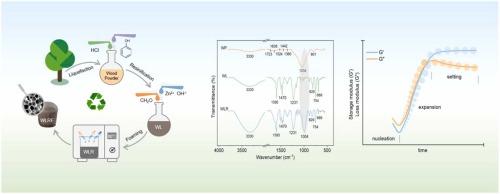当前位置:
X-MOL 学术
›
Ind. Crops Prod.
›
论文详情
Our official English website, www.x-mol.net, welcomes your
feedback! (Note: you will need to create a separate account there.)
One-pot synthesis of foamable bio-resin: High solid content, low viscosity and rapid low-temperature curing
Industrial Crops and Products ( IF 5.6 ) Pub Date : 2024-10-16 , DOI: 10.1016/j.indcrop.2024.119807
Yundan Dong , Qian Zhang , Zhang Zhang , Jie Lin , Jiajun Ji , Fengwen Sun
Industrial Crops and Products ( IF 5.6 ) Pub Date : 2024-10-16 , DOI: 10.1016/j.indcrop.2024.119807
Yundan Dong , Qian Zhang , Zhang Zhang , Jie Lin , Jiajun Ji , Fengwen Sun

|
The increasing global concerns surrounding sustainable resource development and energy-efficient utilisation have positioned the functional utilisation of natural biomass materials as a critical research hotspot in materials science. This study aims to enhance the utilisation of lignocellulose, a highly promising and abundant renewable energy source, to replace petroleum-based materials with wood-based materials. To achieve this objective, the study employed techniques such as liquefaction degradation, molecular reconstruction and directional induction to synthesise wood-based resin through a one-pot process, using poplar powder. The resulting resin exhibited a solid content ranging from 65 % to 68 % and viscosity between 8000 and 4000 mPa·s. Compared with resin formulations lacking divalent metal ions, the resin containing these ions demonstrated an approximate reduction of 8°C in peak curing temperature and a 42.96 % decrease in curing time. These characteristics satisfy the requirements for foaming resins, including high solid content, low viscosity and rapid curing at low temperatures. Additionally, the impacts of resin rheology and thermosetting on the foam pore structure were analysed using principles of rheology and thermodynamics. The integrated manufacturing process of the resin resulted in zero waste or by-products, thereby enhancing efficiency, conserving energy and demonstrating promising market prospects.
中文翻译:

一锅法合成可发泡生物树脂:高固含量、低粘度和快速低温固化
全球对可持续资源开发和节能利用的日益关注使天然生物质材料的功能利用成为材料科学的关键研究热点。本研究旨在提高木质纤维素(一种非常有前途且丰富的可再生能源)的利用,以木质材料取代石油基材料。为了实现这一目标,该研究采用了液化降解、分子重建和定向诱导等技术,使用杨木粉通过一锅法合成木质树脂。所得树脂的固体含量为 65 % 至 68 %,粘度在 8000 至 4000 mPa·s 之间。与不含二价金属离子的树脂配方相比,含有这些离子的树脂的峰值固化温度降低了约 8°C,固化时间缩短了 42.96%。这些特性满足了发泡树脂的要求,包括高固体含量、低粘度和低温快速固化。此外,使用流变学和热力学原理分析了树脂流变学和热固性对泡沫孔结构的影响。树脂的集成制造工艺实现了零浪费或零副产品,从而提高了效率、节约了能源并展示了广阔的市场前景。
更新日期:2024-10-16
中文翻译:

一锅法合成可发泡生物树脂:高固含量、低粘度和快速低温固化
全球对可持续资源开发和节能利用的日益关注使天然生物质材料的功能利用成为材料科学的关键研究热点。本研究旨在提高木质纤维素(一种非常有前途且丰富的可再生能源)的利用,以木质材料取代石油基材料。为了实现这一目标,该研究采用了液化降解、分子重建和定向诱导等技术,使用杨木粉通过一锅法合成木质树脂。所得树脂的固体含量为 65 % 至 68 %,粘度在 8000 至 4000 mPa·s 之间。与不含二价金属离子的树脂配方相比,含有这些离子的树脂的峰值固化温度降低了约 8°C,固化时间缩短了 42.96%。这些特性满足了发泡树脂的要求,包括高固体含量、低粘度和低温快速固化。此外,使用流变学和热力学原理分析了树脂流变学和热固性对泡沫孔结构的影响。树脂的集成制造工艺实现了零浪费或零副产品,从而提高了效率、节约了能源并展示了广阔的市场前景。

































 京公网安备 11010802027423号
京公网安备 11010802027423号